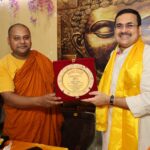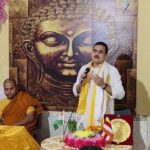THE MAN AND HIS CONVICTION
- By : Anirban Ganguly
- Category : Articles
Syama Prasad Mookerjee never bowed to Nehruvian pressures when it came to the larger good of the country
Making an assessment of Syama Prasad Mookerjee’s life and personality, sometime in 1959, S Radhakrishnan, then Vice President of India, had perhaps come nearest to describing the essential and defining character trait of the late leader, when he wrote that “in his public life”, Mookerjee, “was never afraid of expressing his inmost convictions.”
Such a dauntless power, the philosopher statesman argued, was becoming rare because of the rising habit in our public life of maintaining an unconcerned, or interest-induced silence in face of oppression, injustice or plain lies. “In silence”, Radhakrishnan reminded his readers, “the cruelest lies are told. When great wrongs are committed it is criminal to be silent in the hope that truth will one day find its voice. In a democratic society one should speak out, especially when we are developing an unequalled power of not seeing what we do not wish to see.”
It was his capacity to speak out and to hold out the truth against the overwhelming and forceful unilateral blinkers that the Nehruvian establishment sought to impose on the newly emerging democratic polity in India, that made Mookerjee stand out among his peers and leave a lasting impression on those who came in touch with him or formed part of his multifaceted national action.
Mookerjee struck as outstanding even those who did not necessarily subscribe to his politics. The legendary British Quaker, pacifist and Gandhian, Horace Alexander, for instance, considered him to be “after Rajagopalachari”, the “ablest man in Indian politics”, one of those rare leaders who combined in himself energy, political expediency and realism. Alexander hoped that India would rather have more of Mookerjee’s kind of political realism than a certain opacity that would soon become the hallmark of the Nehruvian epoch
His ability to strike out a new path or line against the prevailing tendencies and notions of the age endeared him to many a leading mind of his era. An overwhelmed Rabindranath Tagore saw the coming of “a veritable change of climate over” the “educational world” in the country and “the dry branch that had withered away at the wintry touch of Western influence festively putting forth fresh foliage”, when Mookerjee, as Vice-Chancellor of the University of Calcutta, hammering away at calcified colonial convention, invited him to deliver the Convocation Address in Bengali in 1937.
Mookerjee’s contribution in other fields, apart from politics, was striking as well, bringing him out as a leader with a vision that was in tune with a rising and an aspiring India. Under the exigencies and rigours of quotidian politics and under the compulsions of an idée fixe when it comes to his ideological formulations, these other aspects of his thoughts and contemplations have often been overlooked or obscured.
His keenness to see cutting-edge research in the field of nuclear energy, for example, was an expression of his will to see India self-reliant. In 1948, while inaugurating the Institute of Nuclear Physics in Calcutta, Mookerjee displayed a deep insight into the future of India’s energy needs when he said, referring to the “peace-time applications of atomic energy” that “it places in the hands of man a source of power limitless in quantity, transportable to every region of the world and usable for every need of mankind.” In trying to harness this mighty source of energy, Mookerjee pointed out, “India cannot remain a mere spectator, particularly when she has all the raw materials in plenty for the development of atomic energy” and especially when “within our own lifetime, we may find the results of atomic energy research affecting all the phases of human life.”
But Mookerjee was perhaps his eloquent best when dilating on the theme of Indian education. His convocation speeches delivered all across India and over decades read like a veritable discussion on the challenges, potential and future of Indian education. They reveal a mind in relentless quest and pursuit of educational excellence in India, a mind which dreamt of re-igniting and unleashing the deeper dimensions and potentials of the essential Indian mind, long cramped within the confines of an alien education framework.
He was hinting at a future framework and goal of indigenous education in a free India when Mookerjee told a young audience that Indian universities, if they were to “play their role in the rebuilding of new India, must not regard themselves as exclusive institutions which exist apart from the currents of the country’s life” and would have to “saturate” their alumni with “lessons of India’s history and civilisation” and “instill into them unity and reason, strength and dauntlessness, and inspire them with skill and knowledge and teach them to apply themselves” to national service.
It is as a tribute to Mookerjee’s indomitable conviction and irrepressible democratic spirit that for the first time since independence, this July 6, his 113th birth anniversary, the political thought and vision that he launched and strove to establish against overwhelming odds has finally assumed unalloyed power and primacy. Such a decisive change does present an opportunity of finally drawing-up his vision of India in freedom.

















